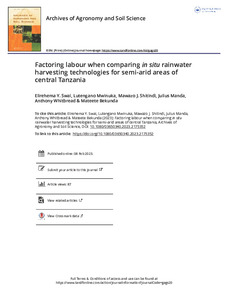| dc.contributor.author | Swai, E. |
| dc.contributor.author | Mwinuka, L. |
| dc.contributor.author | Shitindi, M.J. |
| dc.contributor.author | Manda, J. |
| dc.contributor.author | Whitbread, A. |
| dc.contributor.author | Bekunda, M. |
| dc.date.accessioned | 2023-03-01T10:46:33Z |
| dc.date.available | 2023-03-01T10:46:33Z |
| dc.date.issued | 2023-02-08 |
| dc.identifier.citation | Swai, E., Mwinuka, L., Shitindi, M.J., Manda, J., Whitbread, A. & Bekunda, M. (2023). Factoring labour when comparing in situ rainwater harvesting technologies for semi-arid areas of central Tanzania. Archives of Agronomy and Soil Science, 1-14. |
| dc.identifier.issn | 0365-0340 |
| dc.identifier.uri | https://hdl.handle.net/20.500.12478/8074 |
| dc.description.abstract | Erratic rainfall, high evapotranspiration rates and droughts are major factors limiting crop production in semi-arid areas. Tied ridges that have crossed ties within the furrow are among the physical soil and water conservation measures. During the 2018/19 and 2019/20 seasons, we examined the efficacy of repaired tied ridges for maize crop (Zea mays) and sorghum (Sorghum bicolor) in Kongwa district of Tanzania as an alternate labour saving strategy for managing climate risks associated with variable rainfall. Treatments consisted of three tillage methods: conventional tillage (CT) which involved the preparation of a flat seedbed using handhoe, annually constructed tied ridges (ATR) and tied ridges that had been constructed during the previous season and had been repaired (residual tied ridges–RTR). Data were collected on labour requirements and crop performance. RTR increased economic returns by 29% and 80% over ATR and CT, respectively. Maize grain yield shows a trend of RTR >ATR>CT with values ranging from 2465 kg ha−1 to 4185 kg ha−1 (P < 0.01). While tillage and/or variety did not influence sorghum grain yield significantly (P > 0.05). The use of RTR is recommended because of low labour requirements and greater economic benefits than CT and ATR under maize cropping systems. |
| dc.description.sponsorship | United States Agency for International Development |
| dc.format.extent | 1-14 |
| dc.language.iso | en |
| dc.subject | Ridge Till |
| dc.subject | Labour |
| dc.subject | Economic Benefits |
| dc.subject | Rain |
| dc.subject | Semiarid Zones |
| dc.subject | Tanzania |
| dc.title | Factoring labour when comparing in situ rainwater harvesting technologies for semi-arid areas of central Tanzania |
| dc.type | Journal Article |
| cg.contributor.crp | Maize |
| cg.contributor.affiliation | Tanzania Agricultural Research Institute |
| cg.contributor.affiliation | University of Dodoma |
| cg.contributor.affiliation | Sokoine University of Agriculture |
| cg.contributor.affiliation | International Institute of Tropical Agriculture |
| cg.contributor.affiliation | International Livestock Research Institute |
| cg.coverage.region | Africa |
| cg.coverage.region | East Africa |
| cg.coverage.country | Tanzania |
| cg.coverage.hub | Eastern Africa Hub |
| cg.researchtheme | Natural Resource Management |
| cg.identifier.bibtexciteid | SWAI:2023 |
| cg.isijournal | ISI Journal |
| cg.authorship.types | CGIAR and developing country institute |
| cg.iitasubject | Climate Change |
| cg.iitasubject | Food Security |
| cg.iitasubject | Livelihoods |
| cg.iitasubject | Maize |
| cg.iitasubject | Post-Harvesting Technology |
| cg.iitasubject | Smallholder Farmers |
| cg.iitasubject | Socioeconomy |
| cg.journal | Archives of Agronomy and Soil Science |
| cg.notes | Published online: 08 Feb 2023 |
| cg.accessibilitystatus | Limited Access |
| cg.reviewstatus | Peer Review |
| cg.usagerightslicense | Copyrighted; all rights reserved |
| cg.targetaudience | Scientists |
| cg.identifier.doi | https://doi.org/10.1080/03650340.2023.2175352 |
| cg.iitaauthor.identifier | Julius Manda: 0000-0002-9599-5906 |
| cg.iitaauthor.identifier | Mateete Bekunda: 0000-0001-7297-9383 |
| cg.futureupdate.required | No |

